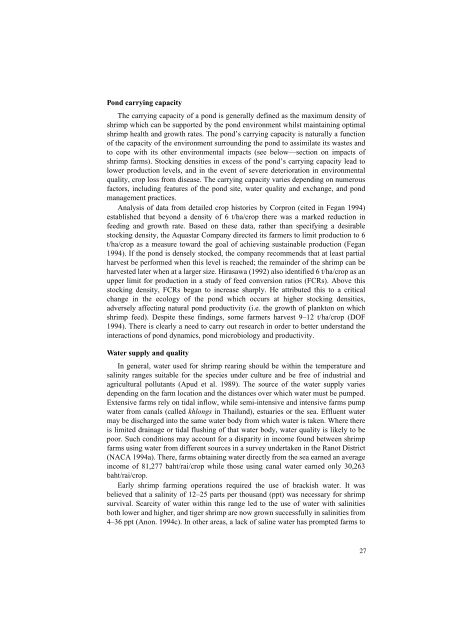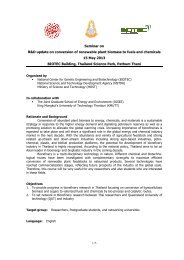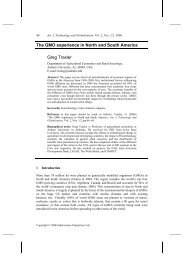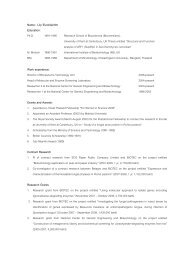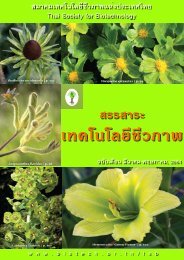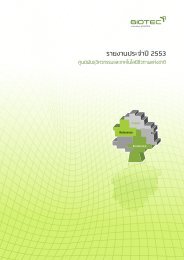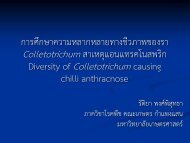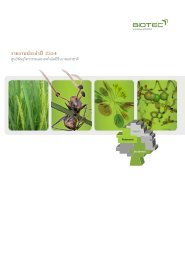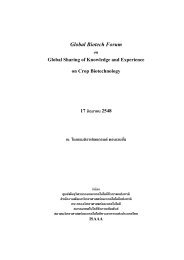!Production Practices and TechniquesThe production methods and management practices of shrimp farms vary betweenareas and between <strong>in</strong>dividual farms. Furthermore, the methods employed by eachfarmer are necessarily dynamic, governed by the chang<strong>in</strong>g condition of the shrimp,the water quality of the ponds, and by the acquisition of new knowledge. This lack ofconsistency makes it difficult to describe the exact practices <strong>in</strong>volved <strong>in</strong> shrimp farm<strong>in</strong>g.Instead, an overview of techniques and pr<strong>in</strong>ciples is presented here. As <strong>in</strong>tensivefarm<strong>in</strong>g produces most of <strong>Thailand</strong>’s shrimp, this method of production is given themost attention.Larvae and hatcheriesThe development of hatchery techniques <strong>in</strong> the late 1960s (Liao 1990), togetherwith successful <strong>in</strong>duction of spawn<strong>in</strong>g <strong>in</strong> tiger and banana shrimp <strong>in</strong> 1973 (Suraswadi1990) allowed shrimp farmers to <strong>in</strong>crease stock<strong>in</strong>g densities and consequently production.Prior to this, only wild seed stocks were available which were not alwaysreliable. At present, very few farms use wild-caught postlarvae <strong>in</strong> <strong>Thailand</strong> (M.J.Phillips, pers. comm.).In <strong>Thailand</strong> <strong>in</strong> 1989, there were 2,000 private hatcheries produc<strong>in</strong>g an estimated12,100 million shrimp juveniles (Suraswadi 1990). In 1997, there were an estimated1,000 hatcheries (Funge-Smith 1997). Government fishery research stations are also<strong>in</strong>volved <strong>in</strong> the production and supply of postlarvae. Concrete tanks or shallow pondsmade of bricks are generally used, allow<strong>in</strong>g m<strong>in</strong>imal costs <strong>for</strong> construction and operation.Other operations use fibreglass tanks. Hypersal<strong>in</strong>e water is often obta<strong>in</strong>ed fromsalt pans—this is relatively free of pathogens because of its high sal<strong>in</strong>ity. The survivalrate <strong>in</strong> hatcheries may be as high as 95% (Suraswadi 1990), however it isusually between 40–50% <strong>in</strong> small-scale hatcheries.Juveniles are purchased by farmers at between 10 and 30 days after moult<strong>in</strong>g tothe postlarvae stage (PL10–30), but usually between 14 and 18 days (PL14–18)(NACA 1994a). In 1997, prices <strong>for</strong> PL12–15 were US$3.43 to US$4.06 per thousand(Funge-Smith 1997).Stock<strong>in</strong>g densityStock<strong>in</strong>g density is determ<strong>in</strong>ed by a number of factors <strong>in</strong>clud<strong>in</strong>g pond size,quality of the available water supply, the type of technology used by the farm and thelevel of production desired. The goal of the farmer is, understandably, to achieve thegreatest possible production to maximise profits. In many <strong>in</strong>stances, farmers stocktheir ponds at a very high density <strong>in</strong>itially with the <strong>in</strong>tent to offset losses <strong>in</strong>curredlater. A particular stock<strong>in</strong>g density, however, does not ensure a particular output(NACA 1994a) as mortality rates vary. Reasons <strong>for</strong> this <strong>in</strong>clude death of larvae fromthe stresses <strong>in</strong>duced by transport or disease or—at later stages <strong>in</strong> growth—fromdisease or from syndromes related to deterioration of water quality. A study by Chaiyukumet al. (1992, cited <strong>in</strong> NACA 1994a) found a very variable survival ratebetween the time of <strong>in</strong>itial stock<strong>in</strong>g of ponds and harvest (25.9–81.5%), even with arelatively low stock<strong>in</strong>g density of 25 shrimp/m 2 .+%
!Pond carry<strong>in</strong>g capacityThe carry<strong>in</strong>g capacity of a pond is generally def<strong>in</strong>ed as the maximum density ofshrimp which can be supported by the pond environment whilst ma<strong>in</strong>ta<strong>in</strong><strong>in</strong>g optimalshrimp health and growth rates. The pond’s carry<strong>in</strong>g capacity is naturally a functionof the capacity of the environment surround<strong>in</strong>g the pond to assimilate its wastes andto cope with its other environmental impacts (see below—section on impacts ofshrimp farms). Stock<strong>in</strong>g densities <strong>in</strong> excess of the pond’s carry<strong>in</strong>g capacity lead tolower production levels, and <strong>in</strong> the event of severe deterioration <strong>in</strong> environmentalquality, crop loss from disease. The carry<strong>in</strong>g capacity varies depend<strong>in</strong>g on numerousfactors, <strong>in</strong>clud<strong>in</strong>g features of the pond site, water quality and exchange, and pondmanagement practices.Analysis of data from detailed crop histories by Corpron (cited <strong>in</strong> Fegan 1994)established that beyond a density of 6 t/ha/crop there was a marked reduction <strong>in</strong>feed<strong>in</strong>g and growth rate. Based on these data, rather than specify<strong>in</strong>g a desirablestock<strong>in</strong>g density, the Aquastar Company directed its farmers to limit production to 6t/ha/crop as a measure toward the goal of achiev<strong>in</strong>g susta<strong>in</strong>able production (Fegan1994). If the pond is densely stocked, the company recommends that at least partialharvest be per<strong>for</strong>med when this level is reached; the rema<strong>in</strong>der of the shrimp can beharvested later when at a larger size. Hirasawa (1992) also identified 6 t/ha/crop as anupper limit <strong>for</strong> production <strong>in</strong> a study of feed conversion ratios (FCRs). Above thisstock<strong>in</strong>g density, FCRs began to <strong>in</strong>crease sharply. He attributed this to a criticalchange <strong>in</strong> the ecology of the pond which occurs at higher stock<strong>in</strong>g densities,adversely affect<strong>in</strong>g natural pond productivity (i.e. the growth of plankton on whichshrimp feed). Despite these f<strong>in</strong>d<strong>in</strong>gs, some farmers harvest 9–12 t/ha/crop (DOF1994). There is clearly a need to carry out research <strong>in</strong> order to better understand the<strong>in</strong>teractions of pond dynamics, pond microbiology and productivity.Water supply and qualityIn general, water used <strong>for</strong> shrimp rear<strong>in</strong>g should be with<strong>in</strong> the temperature andsal<strong>in</strong>ity ranges suitable <strong>for</strong> the species under culture and be free of <strong>in</strong>dustrial andagricultural pollutants (Apud et al. 1989). The source of the water supply variesdepend<strong>in</strong>g on the farm location and the distances over which water must be pumped.Extensive farms rely on tidal <strong>in</strong>flow, while semi-<strong>in</strong>tensive and <strong>in</strong>tensive farms pumpwater from canals (called khlongs <strong>in</strong> <strong>Thailand</strong>), estuaries or the sea. Effluent watermay be discharged <strong>in</strong>to the same water body from which water is taken. Where thereis limited dra<strong>in</strong>age or tidal flush<strong>in</strong>g of that water body, water quality is likely to bepoor. Such conditions may account <strong>for</strong> a disparity <strong>in</strong> <strong>in</strong>come found between shrimpfarms us<strong>in</strong>g water from different sources <strong>in</strong> a survey undertaken <strong>in</strong> the Ranot District(NACA 1994a). There, farms obta<strong>in</strong><strong>in</strong>g water directly from the sea earned an average<strong>in</strong>come of 81,277 baht/rai/crop while those us<strong>in</strong>g canal water earned only 30,263baht/rai/crop.Early shrimp farm<strong>in</strong>g operations required the use of brackish water. It wasbelieved that a sal<strong>in</strong>ity of 12–25 parts per thousand (ppt) was necessary <strong>for</strong> shrimpsurvival. Scarcity of water with<strong>in</strong> this range led to the use of water with sal<strong>in</strong>itiesboth lower and higher, and tiger shrimp are now grown successfully <strong>in</strong> sal<strong>in</strong>ities from4–36 ppt (Anon. 1994c). In other areas, a lack of sal<strong>in</strong>e water has prompted farms to+&
- Page 8 and 9: !The 1994 Workshop had a working hy
- Page 11 and 12: !The Workshop at Hat Yai, SongkhlaA
- Page 13 and 14: !ReferenceSmith, P.T., ed.. 1999. T
- Page 15 and 16: !Shrimp Farming in ThailandOver the
- Page 18 and 19: ! !Table 1. World production (# 1,0
- Page 20 and 21: !Domestic and world demandJapan is
- Page 22 and 23: !Intensification of farms has been
- Page 24 and 25: !no significant difference between
- Page 28 and 29: !use water which is almost fresh (F
- Page 30 and 31: !mended quantities for application
- Page 32 and 33: !the biological processes in sedime
- Page 34 and 35: !factors (Fegan 1994). Environmenta
- Page 36 and 37: !Acid sulphate soils occur in most
- Page 38 and 39: during the rainy season, some deter
- Page 40 and 41: Land subsidenceCoastal land subside
- Page 42 and 43: first when an area becomes environm
- Page 44 and 45: !Administration. Their work has inv
- Page 46 and 47: agriculture, selects coastal land p
- Page 48 and 49: Sustainability, Sustainable Develop
- Page 50 and 51: cultural and environmental asset va
- Page 52 and 53: $+Table 12. (cont’d) Impediments
- Page 54 and 55: $#Table 12. (cont’d) Impediments
- Page 56 and 57: $%Table 12. (cont’d) Impediments
- Page 58 and 59: capacities of alternative organisms
- Page 60 and 61: sources. This is one of the greates
- Page 62 and 63: Table 13. (cont’d) Summary of the
- Page 64 and 65: Boonyapiwat, S. 1989. Species of ph
- Page 66 and 67: Katesombun, B. 1992. Aquaculture pr
- Page 68 and 69: Sirisup, S. 1988 Socio-economic cha
- Page 70 and 71: !In the preliminary analysis, the s
- Page 72 and 73: !until all variables had been teste
- Page 74 and 75: !quality problem over the past 3 ye
- Page 76 and 77:
!Figure 1. Characterisation of prov
- Page 78 and 79:
!Variables Contributing to Shrimp P
- Page 80 and 81:
!Figure 5. Relationship between ave
- Page 82 and 83:
!southern). The linear regression m
- Page 84 and 85:
!Appendix. Results of logistic regr
- Page 86 and 87:
!2) Trat ProvinceClassification tab
- Page 88 and 89:
!Chi-square df significanceModel Ch
- Page 90 and 91:
!8) Satun ProvinceClassification ta
- Page 92 and 93:
!Variables in the equationConstant
- Page 94 and 95:
!A total of 49 participants were in
- Page 96 and 97:
! ! ! ! ! ! ! ! ! ! ! ! ! ! ! ! !Fi
- Page 98 and 99:
!All issues are listed in Appendice
- Page 100 and 101:
!!were short term and one issue was
- Page 102 and 103:
!reared broodstock (issue 71). They
- Page 104 and 105:
!!Two participants commented that i
- Page 106 and 107:
mation transfer and training. This
- Page 108 and 109:
108Appendix 1. (cont’d) Descripti
- Page 110 and 111:
110Appendix 1. (cont’d) Descripti
- Page 112 and 113:
112Appendix 2. Descriptive statisti
- Page 114 and 115:
114Appendix 2. (cont’d) Descripti
- Page 116 and 117:
116Appendix 3. Descriptive statisti
- Page 118 and 119:
118Appendix 4. Descriptive statisti
- Page 120 and 121:
120Appendix 5. Descriptive statisti
- Page 122 and 123:
Appendix 5. (cont’d) Descriptive
- Page 124 and 125:
Appendix 7. Descriptive statistics
- Page 126 and 127:
Appendix 7. (cont’d) Descriptive
- Page 128 and 129:
128Appendix 8. (cont’d) Descripti
- Page 130 and 131:
!ParticipantsAustraliaDr Paul T. Sm


